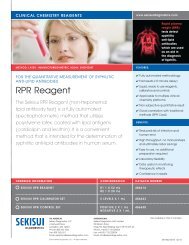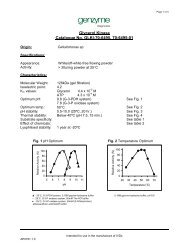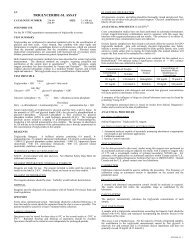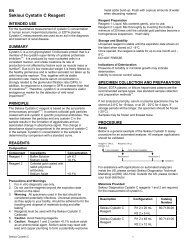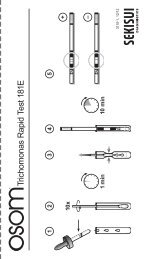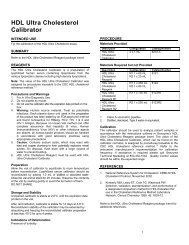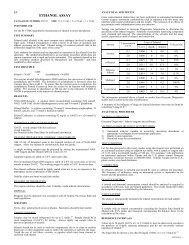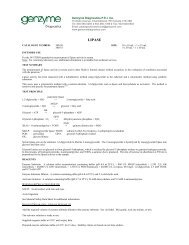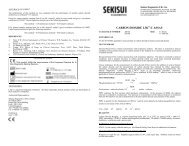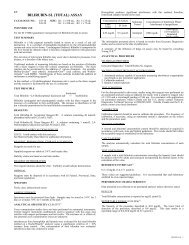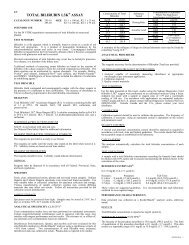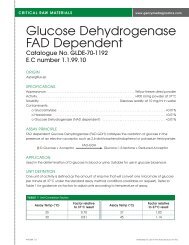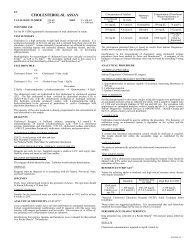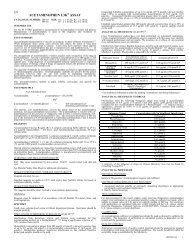Réactif lipasique Liquid N-geneous - Sekisui Diagnostics
Réactif lipasique Liquid N-geneous - Sekisui Diagnostics
Réactif lipasique Liquid N-geneous - Sekisui Diagnostics
Create successful ePaper yourself
Turn your PDF publications into a flip-book with our unique Google optimized e-Paper software.
<strong>Liquid</strong> N-geneous Lipase (U/L)<br />
500<br />
400<br />
300<br />
200<br />
100<br />
<strong>Liquid</strong> N-geneous Lipase vs LCK Lipase<br />
0<br />
0 100 200 300 400 500 600 700 800<br />
LCK (U/L)<br />
Précision<br />
La précision du réactif <strong>Liquid</strong> N-geneous Lipase a été déterminée à<br />
partir d'échantillons effectués en double exemplaire, deux fois par jour<br />
pendant 20 jours avec l'analyseur Roche Hitachi 912, à travers 20<br />
étalonnages et 4 lots de réactifs, en utilisant pour ce faire 3 niveaux de<br />
sérum humain par mélange, avec un ajout de lipases pancréatiques<br />
humaines suivant la norme NCCLS EP5. 10<br />
Les données suivantes<br />
proviennent d’un lot représentatif.<br />
Précision intersérielle<br />
Mélange<br />
sérique<br />
Récupération<br />
moyenne (U/L)<br />
Écart type<br />
(U/L) CV<br />
Niveau 1 24 0,29 1,2 %<br />
Niveau 2 56 0,59 1,0 %<br />
Niveau 3 129 0,82 0,6 %<br />
Précision totale<br />
Mélange<br />
sérique<br />
Récupération<br />
moyenne (U/L)<br />
Écart type<br />
(U/L) CV<br />
Niveau 1 24 0,56 2,3 %<br />
Niveau 2 56 1,16 2,1 %<br />
Niveau 3 129 2,47 1,9 %<br />
Limite du Blanc<br />
La Limite du Blanc correspond au taux de concentration qui sur le plan<br />
statistique n’est pas distinguable de zéro. Une solution saline a été<br />
combinée et écoulée à 20 reprises avec le réactif <strong>Liquid</strong> N-geneous<br />
Lipase sur l’analyseur clinique Roche/Hitachi 912 et la moyenne plus<br />
deux écarts standard d’un échantillon ayant contenu 0 U/L de lipase a été<br />
utilisé pour définir le seuil limite de détection : Un volume de 0 U/L de<br />
lipase a été utilisé pour définir la limite de détection : 0,3 U/L.<br />
Spécificité<br />
Les substances suivantes, aux concentrations présentées, n’ont pas eu<br />
d’incidence sur les performances (biais < 10 %) du dosage <strong>Liquid</strong> N-<br />
geneous Lipase sur un mélange sérique avec un volume <strong>lipasique</strong><br />
d’environ 47 U/L : 7<br />
Substance<br />
Bilirubine, Conjuguée & non-conj.<br />
Hémoglobine<br />
Acide ascorbique<br />
Intralipid ®<br />
Glycérole<br />
Acétaminophène (paracétamole)<br />
Acide acétylsalicylique<br />
Ampicilline<br />
Caféine<br />
Captoprile<br />
Maléate de chlorphéniramine<br />
Cimétidine<br />
Cyclosporine U<br />
Hyclate de doxycyline<br />
Furosémide<br />
Ibuprofen<br />
Indométhacine<br />
Concentration Testée<br />
60 mg/dL<br />
500 mg/dL<br />
125 mg/dL<br />
1,2 % (3,600 mg/dL trig)<br />
600 mg/dL<br />
20 mg/dL<br />
50 mg/dL<br />
5 mg/dL<br />
10 mg/dL<br />
6 mg/dL<br />
0,8 mg/dL<br />
10 mg/dL<br />
0,8 mg/dL<br />
6 mg/dL<br />
2 mg/dL<br />
40 mg/dL<br />
1 mg/dL<br />
Lévodopa<br />
Lovastatine<br />
Méthotrexate<br />
Méthyldopa<br />
Métoprolol tartrate<br />
Métronidazole<br />
Acide nicotinique<br />
Oméprazole<br />
Prednisone<br />
Hydrochloride de prométhazine<br />
Hydrochloride de propanolol<br />
Sulphate de quinidine<br />
Simvastatine<br />
Théophylline<br />
Tolbutamide<br />
160 mg/dL<br />
1,6 mg/dL<br />
450 mg/dL<br />
2,5 mg/dL<br />
0,3 mg/dL<br />
1 mg/dL<br />
2 mg/dL<br />
7,2 mg/dL<br />
1,2 mg/dL<br />
1 mg/dL<br />
0,5 mg/dL<br />
5 mg/dL<br />
0,8 mg/dL<br />
25 mg/dL<br />
100 mg/dL<br />
Linéarité<br />
En appliquant le protocole EP6 11 , de la norme NCCLS, la méthode <strong>Liquid</strong><br />
N-geneous Lipase présente une linéarité allant de 0,3 à 400 U/L. Les<br />
échantillons étaient des mélanges sériques élevés et faibles.<br />
Les prélèvements supérieurs à 400 U/L peuvent être dilués avec une<br />
solution physiologique saline. Les échantillons peuvent être dilués en<br />
deux fois. Pour obtenir le taux de concentration des lipases contenues<br />
dans l’échantillon, multipliez le résultat par le facteur de dilution.<br />
Références<br />
1. Tietz NW, Lipase in Serum – The Elusive Enzyme: an Overview.<br />
Clin Chem 1993; Vol. 39, No. 5.<br />
2. Tietz NW, Textbook of Clinical Chemistry, 2 nd ed., WB Saunders<br />
Co., Philadelphia, PA: 865, 1986.<br />
3. Neumann U, Kaspar P, Ziegenhorn J and Bergmeyer HU, Methods<br />
of Enzymatic Analysis, 3 rd ed. Vol. 4: 26-34, 1984.<br />
4. Richardson JH and Barkley WE, eds. Biosafety in Microbiological<br />
and Biomedical Laboratories, U.S. Dept. of Health and Human<br />
Services, Public Health Service, HHS Publication No. (CDC) 84-<br />
8395, Washington, DC: 1984.<br />
5. National Committee for Clinical Laboratory Standards, Procedures<br />
for the Handling and Processing of Blood Specimens: Approved<br />
Guideline. NCCLS Document H18-A, Villanova, PA: 1990.<br />
6. National Committee for Clinical Laboratory Standards. Interference<br />
Testing in Clinical Chemistry: Approved Guideline. NCCLS<br />
document EP7-A. Villanova, PA: 2002.<br />
7. Young, DS, Effects of Drugs on Clinical Laboratory Tests, 3 rd ed.,<br />
Washington, D.C.:AACC Press, 1990.<br />
8. National Committee for Clinical Laboratory Standards. How to<br />
Define and Determine Reference Intervals in the Clinical Laboratory;<br />
Approved Guideline. NCCLS document C28-A, Villanova, PA: 2002.<br />
9. National Committee for Clinical Laboratory Standards. Method<br />
Comparison and Bias Estimation Using Patient Samples; Approved<br />
Guideline. NCCLS document EP9-A. Villanova, PA: 2002.<br />
10. National Committee for Clinical Laboratory Standards. Evaluation of<br />
Precision Performance of Clinical Chemistry Devices; Approved<br />
Guideline. NCCLS document EP5-A. Villanova, PA: 1999.<br />
11. National Committee for Clinical Laboratory Standards. Evaluation of<br />
the Linearity of Quantitative Measurement Procedures: A Statistical<br />
Approach; Approved Guideline. NCCLS document EP6-A. Villanova,<br />
PA: 2003.



